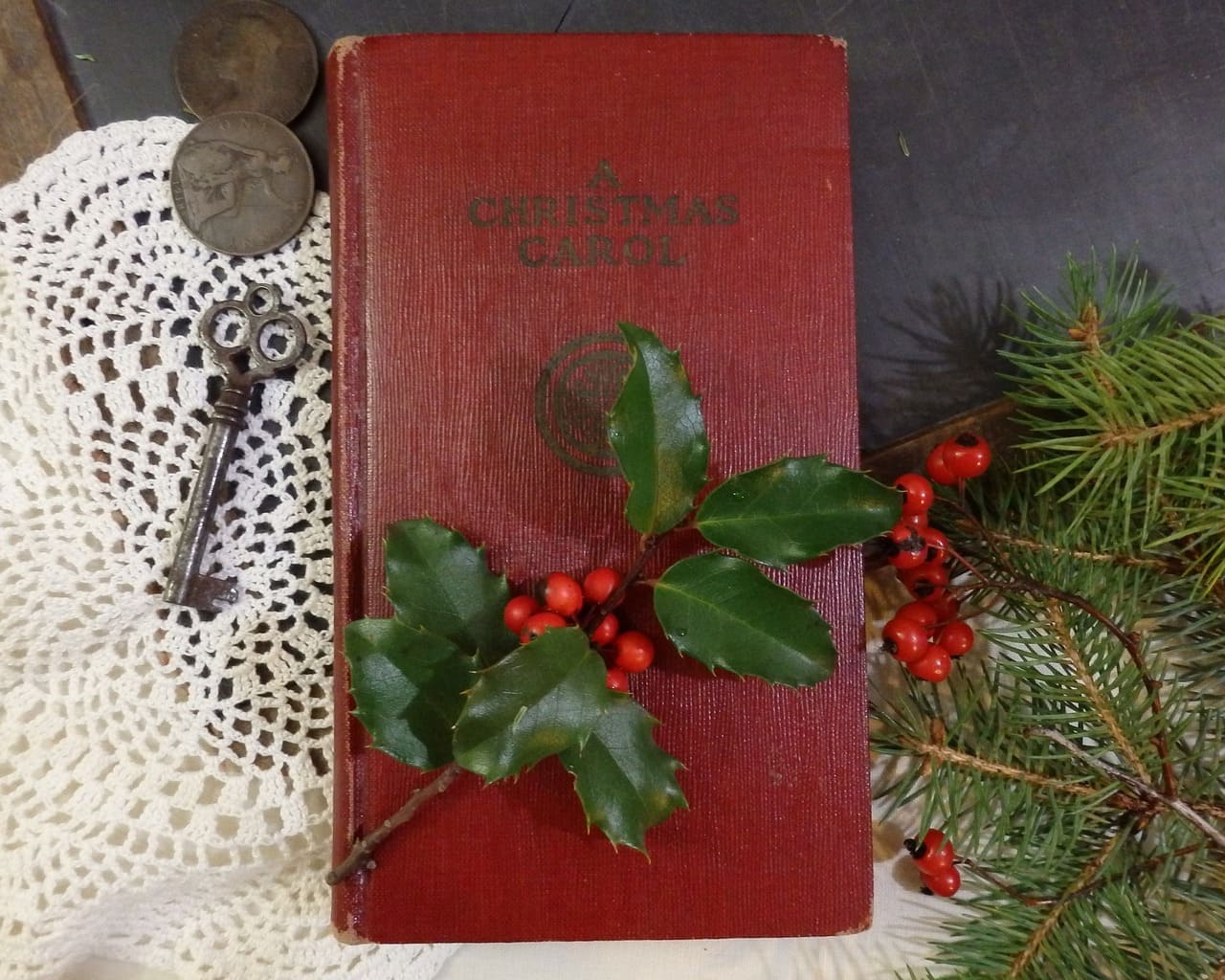📗 “I will honour Christmas in my heart, and try to keep it all the year. I will live in the Past, the Present, and the Future. The Spirits of all Three shall strive within me. I will not shut out the lessons that they teach.”
– Charles Dickens, A Christmas Carol (1843)
What better time of year than to turn to one of the most influential short novels in English literature! Charles Dickens’ A Christmas Carol (1843) has in fact been ranked among Penguin Books’ list of ‘100 Must–Read Novels’ of all time.
Today’s Lesson will provide a short overview of the book for anyone who hasn’t yet read it or would like to review it. We will finish the Lesson by outlining the six main tenses in English (past simple and continuous, present simple and continuous, and future simple and continuous) with excerpts from Dickens’ wonderful little book.
On account of its being Christmas, I have arranged the content here a little differently today: each stage of the story is presented through an individual image of its own, just as if it were a page in a real book. I hope you like it!
…
📗 A CHRISTMAS CAROL (1843)
This story is about hope and redemption (being saved from error or evil; clearing of a debt).
It is also the story a businessman called Ebenezer Scrooge, a bitter, stingy (not generous), and irritable man with very few friends.
In fact, he lives and works mostly alone ever since his business partner, Jacob Marley, died several years earlier.
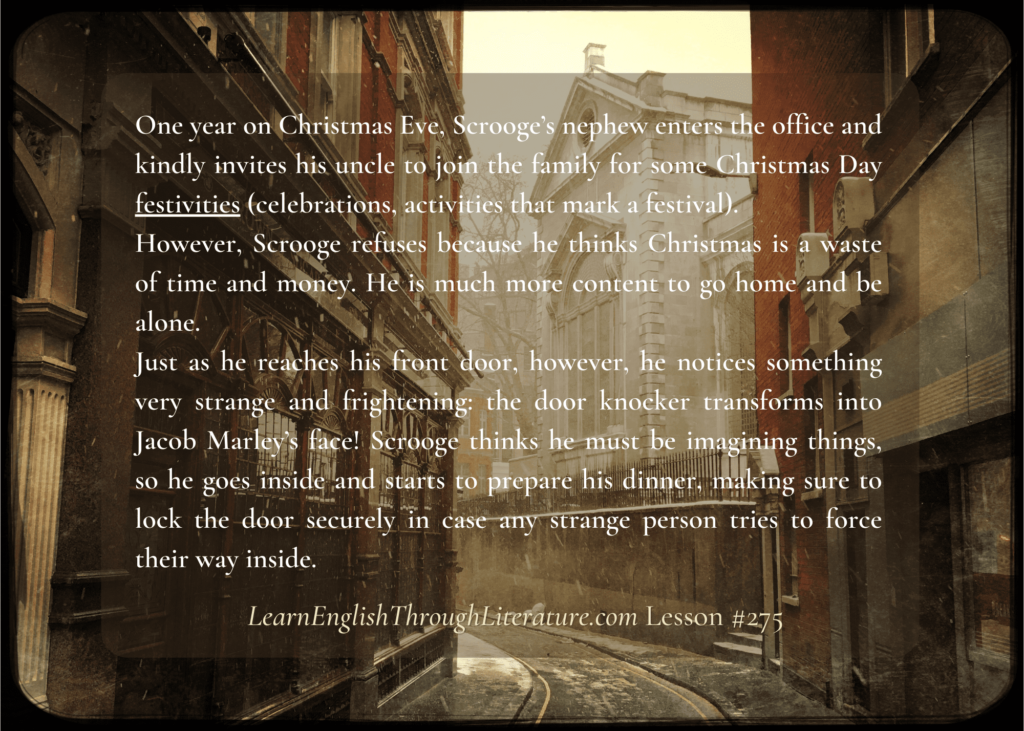
One year on Christmas Eve, Scrooge’s nephew enters the office and kindly invites his uncle to join the family for some Christmas Day festivities (celebrations, activities that mark a festival).
However, Scrooge refuses because he thinks Christmas is a waste of time and money. He is much more content to go home and be alone.
Just as he reaches his front door, however, he notices something very strange and frightening: the door knocker transforms into Jacob Marley’s face! Scrooge thinks he must be imagining things, so he goes inside and starts to prepare his dinner, making sure to lock the door securely in case any strange person tries to force their way inside.
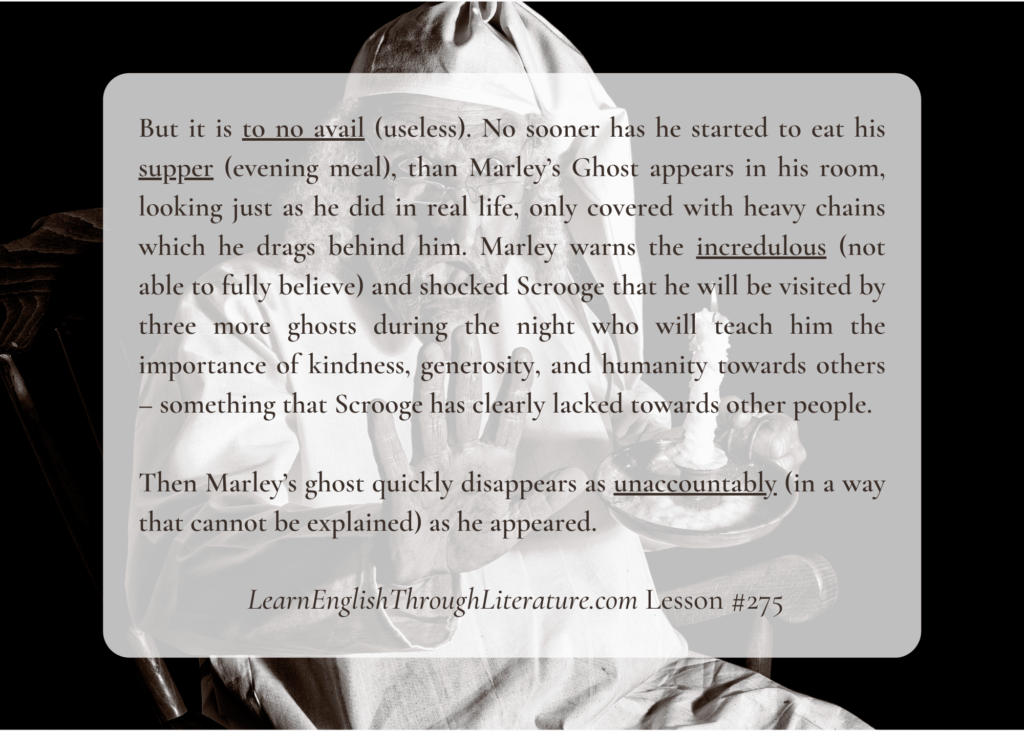
But it is to no avail (useless). No sooner has he started to eat his supper (evening meal), than Marley’s Ghost appears in his room, looking just as he did in real life, only covered with heavy chains which he drags behind him. Marley warns the incredulous (not able to fully believe) and shocked Scrooge that he will be visited by three more ghosts during the night who will teach him the importance of kindness, generosity, and humanity towards others – something that Scrooge has clearly lacked towards other people.
Then Marley’s ghost quickly disappears as unaccountably (in a way that cannot be explained) as he appeared.
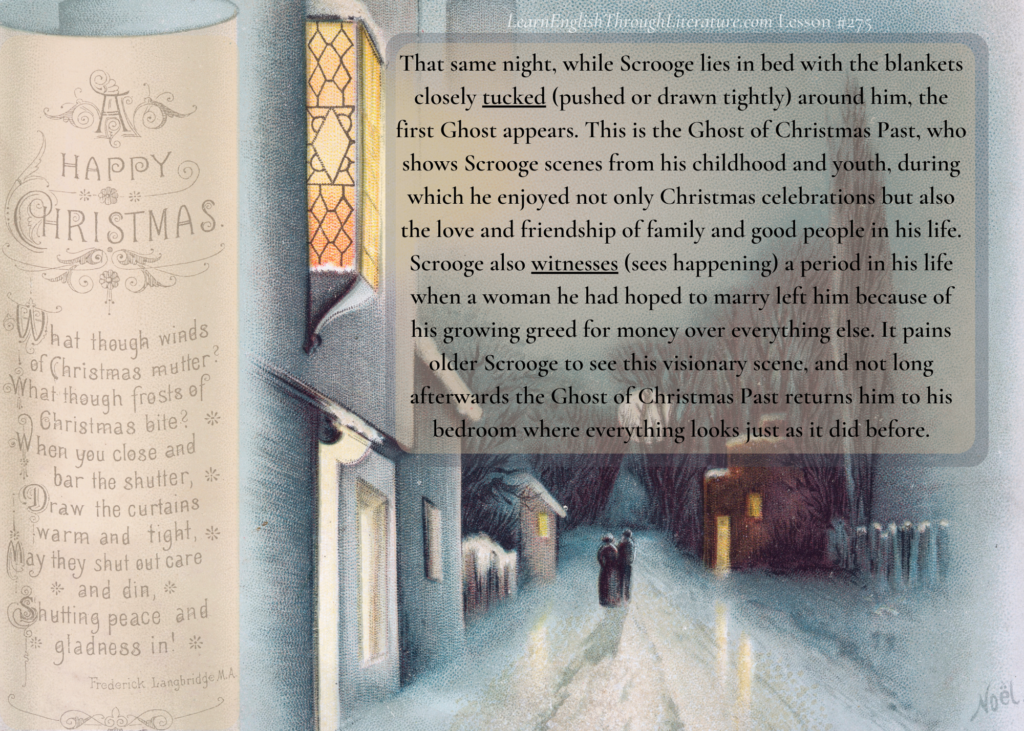
That same night, while Scrooge lies in bed with the blankets closely tucked (pushed or drawn tightly) around him, the first Ghost appears. This is the Ghost of Christmas Past, who shows Scrooge scenes from his childhood and youth, during which he enjoyed not only Christmas celebrations but also the love and friendship of family and good people in his life. Scrooge also witnesses (sees happening) a period in his life when a woman he had hoped to marry left him because of his growing greed for money over everything else. It pains older Scrooge to see this visionary scene, and not long afterwards the Ghost of Christmas Past returns him to his bedroom where everything looks just as it did before.
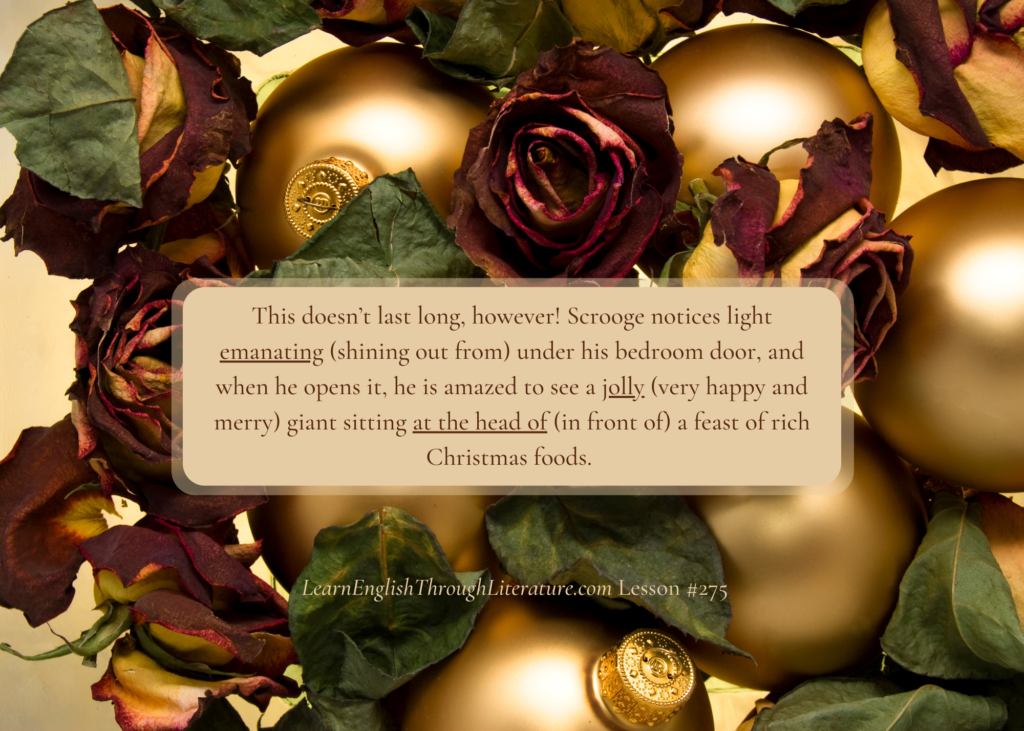
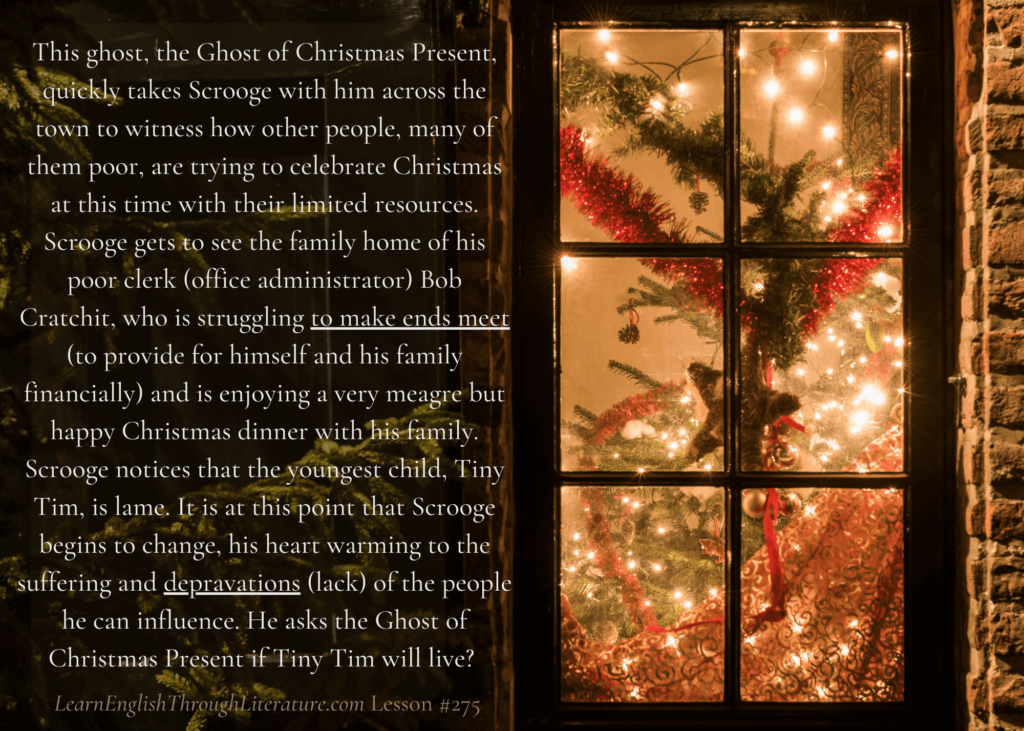
This doesn’t last long, however. Scrooge notices light emanating (shining out from) under his bedroom door, and when he opens it, he is amazed to see a jolly (very happy and merry) giant sitting at the head of (in front of) a feast of rich Christmas foods.
This ghost, the Ghost of Christmas Present, quickly takes Scrooge with him across the town to witness how other people, many of them poor, are trying to celebrate Christmas at this time with their limited resources. Scrooge gets to see the family home of his poor clerk (office administrator) Bob Cratchit, who is struggling to make ends meet (to provide for himself and his family financially) and is enjoying a very meagre but happy Christmas dinner with his family.
Scrooge notices that the youngest child, Tiny Tim Cratchit, is lame. It is at this point that Scrooge begins to change, his heart warming to the suffering and depravations (lack) of the people he can influence. He asks the Ghost of Christmas Present if Tiny Tim will live?
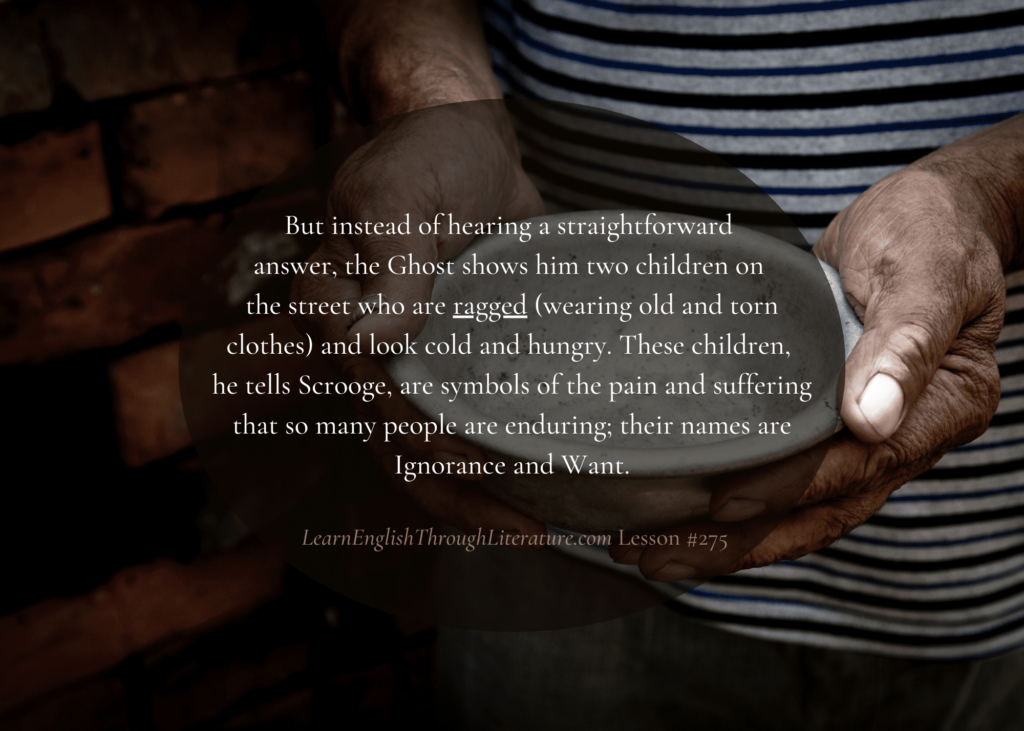
But instead of hearing a straightforward answer, the Ghost shows him two children on the street who are ragged (wearing old and torn) clothes and look cold and hungry. These children, he tells Scrooge, are symbols of the pain and suffering that so many people are enduring; their names are Ignorance and Want.
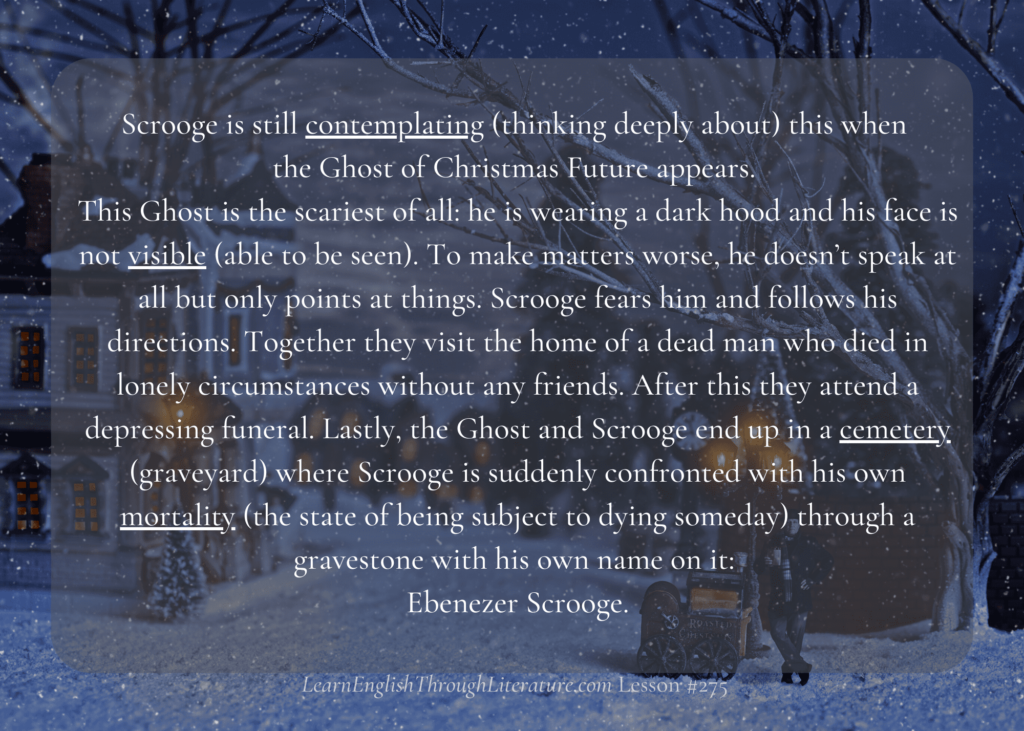
Scrooge is still contemplating (thinking deeply about) this when the Ghost of Christmas Future appears. This Ghost is the scariest of all: he is wearing a dark hood and his face is not visible (able to be seen). To make matters worse, he doesn’t speak at all but only points at things. Scrooge fears him and follows his directions. Together they visit the home of a dead man who died in lonely circumstances without any friends. After this, they attend a depressing funeral. Lastly, the Ghost and Scrooge end up in a cemetery (graveyard) where Scrooge is suddenly confronted with his own mortality (the state of being subject to dying someday) through a gravestone with his own name on it: Ebenezer Scrooge.
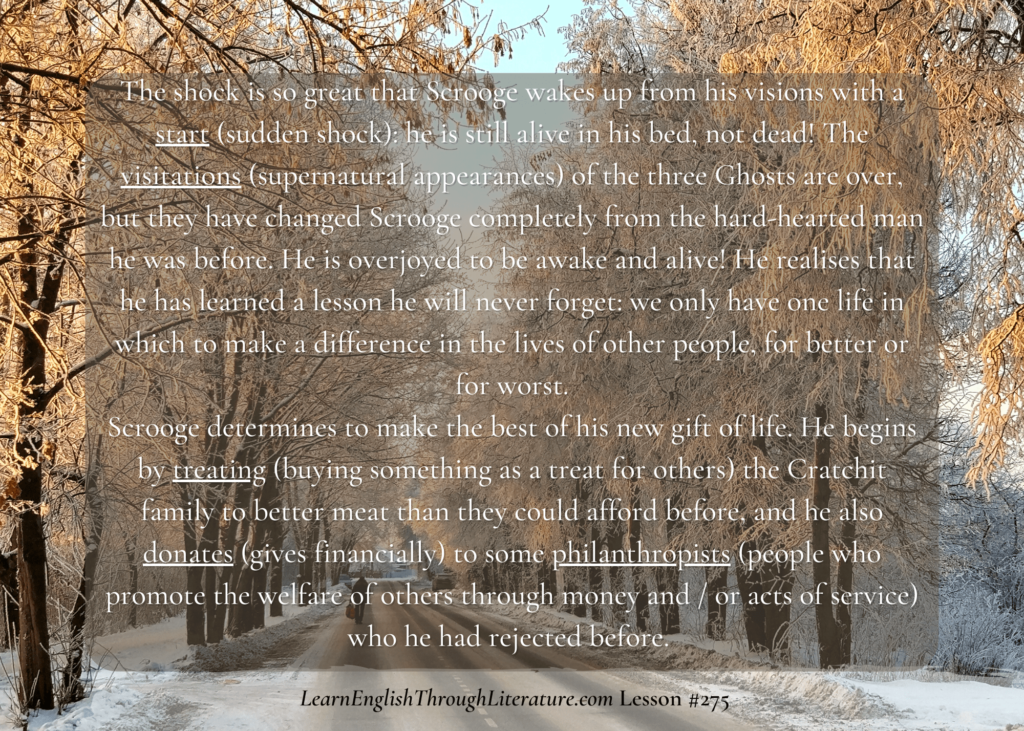
The shock is so great that Scrooge wakes up from his visions with a start (sudden shock): he is still alive in his bed, not dead! The visitations (supernatural appearances) of the three Ghosts are over, but they have changed Scrooge completely from the hard-hearted man he was before. He is overjoyed to be awake and alive! He realises that he has learned a lesson he will never forget: we only have one life in which to make a difference in the lives of other people, for better or for worst.
Scrooge determines to make the best of his new gift of life. He begins by treating (buying for others as a treat) the Cratchit family to better meat than they could afford before, and he also donates (gives financially) to some philanthropists (people who promote the welfare of others through money and / or acts of service) who he had rejected before.
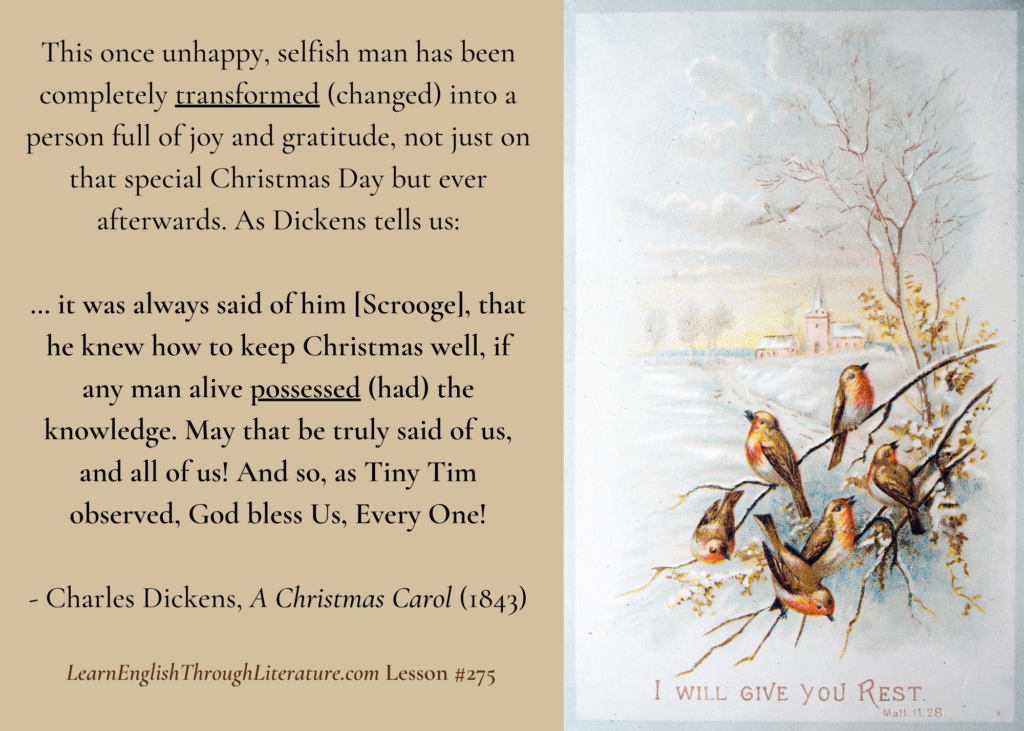
This once unhappy, selfish man has been completely transformed (changed) into a person full of joy and gratitude, not just on that special Christmas Day but ever afterwards. As Dickens tells us:
📗 “… it was always said of him [Scrooge], that he knew how to keep Christmas well, if any man alive possessed (had) the knowledge. May that be truly said of us, and all of us! And so, as Tiny Tim observed, God bless Us, Every One!”
– Charles Dickens, A Christmas Carol (1843)
…
We will now look at two forms (simple and progressive/continuous) of the following tenses: the past, the present, and the future.
📝 THE PAST
These are some of the most famous lines in A Christmas Carol:
📗 “But you were always a good man of business, Jacob,” faltered Scrooge, who now began to apply this to himself.
“Business!” cried the Ghost, wringing its hands again. “Mankind was my business. The common welfare was my business; charity, mercy, forbearance, and benevolence, were, all, my business. The dealings of my trade were but a drop of water in the comprehensive ocean of my business!”
– Charles Dickens, A Christmas Carol (emphases mine)
Can you spot how Dickens used the past simple tense here? Words like were, faltered, cried, began, and was are all examples of this.
Here is another line with plenty of examples of the past simple tense:
📗 ‘He went to church, and walked about the streets, and watched the people hurrying to and fro, and patted children on the head, and questioned beggars, and looked down into the kitchens of houses, and up to the windows, and found that everything could yield him pleasure. He had never dreamed that any walk— that anything— could give him so much happiness. In the afternoon he turned his steps towards his nephew’s house.’
– Charles Dickens, A Christmas Carol (emphases mine)
✍️ The past simple tense describes actions that started and finished in the past.
✍️ On the other hand, the past continuous tense describes actions that were continuing in the past, usually at a certain point in time.
We often use it in response to a question, such as: ‘What were you doing last week?’ ‘I was studying for my exams, I was working, etc.’
Notice it here in this next quotation:
📗 ‘They were looking at the table (which was spread out in great array) …’
– Charles Dickens, A Christmas Carol (emphasis mine)
Notice how Dickens combines both the past simple and past continuous in the following line. (Can you tell which is which? 🤔)
📗 ‘The man thought he was dreaming, but he wasn’t.’
– Charles Dickens, A Christmas Carol (emphasis mine)
And here is an example of the past continuous being conjugated with a negative:
📗 ‘He was not reading now, but walking up and down despairingly.’
– Charles Dickens, A Christmas Carol (emphasis mine)
This final quotation is excellent and includes an example of the past perfect tense, which must be briefly mentioned here.
✍️ This tense is often used in writing or in narrative/storytelling situations. It describes actions that were completed (or not completed) at some point in the past that hasn’t been specified. It is very useful for describing actions that happened along a timeline, that is, one action following another one later on. (You can probably see why it is so useful for telling stories, as in Dickens’ writing!)
👉 We create it by using an auxiliary verb (e.g., ‘have’ or ‘had’) plus the past participle of a verb. In the following quotation, Dickens writes about people who ‘had lost the power [to do good] for ever’:
📗 ‘The misery with them all was, clearly, that they sought to interfere, for good, in human matters, and had lost the power for ever.’
– Charles Dickens, A Christmas Carol (emphases mine)
✍️ We generally use the past perfect tense (sometimes called the pluperfect) to describe the earliest events in a series of actions, while we use the past simple tense to describe the later or more recent past events in the same series of actions. For example, in the sentence above the people who had died without being kind to others in their lifetime A) had lost the power to do good forever, and because of this B) they were miserable and sought (past simple for ‘seek) to interfere for good in human affairs without being able to.
Here is another example of the past perfect and past simple tenses being used in the same sentence:
✒️ I had (already) bought the ingredients for my dinner when my friend invited me to dine at her house.
If you would like to review the past tenses further, I prepared some Lessons on these earlier this year:
- Lesson #149: An Overview of Essential Time Words and Verb Tenses
- Lesson #155: Tenses to Tell Stories With: The Past Simple, Past Progressive, and Past Perfect Continuous
- Lesson #189: ‘We Ought To Use The Pluperfect And Say Wakened …’: All About The Pluperfect/Past Perfect Tense in English
- Lesson #231: How Two Different Tenses Can Be Used Together Correctly In Reported Speech
…
📝 THE PRESENT
Read this conversation between Scrooge and the Ghost of Christmas Present:
📗 “Is there a peculiar flavour in what you sprinkle from your torch?” asked Scrooge.
“There is. My own.”
“Would it apply to any kind of dinner on this day?” asked Scrooge.
“To any kindly given. To a poor one most.”
“Why to a poor one most?” asked Scrooge.
“Because it needs it most.”
– Charles Dickens, A Christmas Carol (emphases mine)
If you have been studying English for some time, you will recognise that the spoken parts of this conversation are mostly in the present simple tense: words like is and needs.
✍️ This tense is used to describe general facts, regular actions, and sometimes even schedules. We can use it to say sentences like ‘She is originally from Wales’ (fact), ‘I study English on workdays’ (describes a schedule) or ‘He eats vegan food’ (a regular action).
Sometimes English language learners confuse the present simple tense with the present continuous (or progressive) tense. This is because native speakers sometimes use the present continuous tense interchangeably with the present simple tense.
However, there are several key distinctions.
✍️ The present continuous tense can describe:
- continuing actions that are happening as we speak: e.g. ‘Are you reading this lesson on your laptop, tablet, or smartphone?’
- actions that are trends (that follow a pattern of popularity): ‘People are becoming more aware of pollution and are using eco-friendly items more and more.’
- one-time actions (usually actions that will happen in the future): e.g., ‘They are getting married next month’.
Notice how Dickens uses the present continuous tense in this conversation between Scrooge’s nephew Fred and his wife, who are talking about Scrooge’s miserable life (the first lines are spoken by Fred’s wife):
📗 “He hasn’t the satisfaction of thinking— ha, ha, ha!— that he is ever going to benefit us with it.”
“… I was only going to say,” said Scrooge’s nephew, “that the consequence of his [Scrooge’s] taking a dislike to us, and not making merry with us, is, as I think, that he loses some pleasant moments, which could do him no harm.”
– Charles Dickens, A Christmas Carol (emphases mine)
How do you know when to use the present simple instead of the present continuous, or vice versa? 🧐
💡 Remember that the present simple tends to be used for regular actions, while the present continuous describes either ongoing or one-time actions.
Take this example:
✒️ ‘Scrooge goes to bed every night at 10 o’clock.’ (The present simple describing his regular action).
vs
✒️ ‘On the night the ghosts appear, Scrooge is still trying to sleep comfortably in his bed in spite of all his fears.’ (The present continuous describes a once-off action – ‘is trying to sleep’ – that will happen on a specific night).
These fine distinctions should be learned if you would like to develop fluency in English. However, don’t worry about confusing them or making mistakes while you are using them because native speakers will still understand you! You will certainly improve and grasp these moods of the present tense with more practice and conversations with native English speakers.
…
📝 THE FUTURE – 📗“Let me behold what I shall be, in days to come!”
– Charles Dickens, A Christmas Carol
✍️ Future simple is used for actions that are planned (or unplanned) for the future. The easiest way to construct the future tense is to use ‘will’ and ‘won’t’, ‘shall’ and ‘shall not’, ‘going to’ and ‘not going to’ in front of the verb root.
📗 “Spirit,” said Scrooge, with an interest he had never felt before, “tell me if Tiny Tim will live.”
“I see a vacant seat,” replied the Ghost, “in the poor chimney-corner, and a crutch without an owner, carefully preserved. If these shadows remain unaltered by the Future, the child will die.”
“No, no,” said Scrooge. “Oh, no, kind Spirit! say he will be spared.”
“If these shadows remain unaltered by the Future, none other of my race,” returned the Ghost, “will find him here. What then? If he be like to die, he had better do it, and decrease the surplus population …”
“Man,” said the Ghost, … “Will you decide what men shall live, what men shall die?”
– Charles Dickens, A Christmas Carol (emphases mine)
📗 “I will live in the Past, the Present, and the Future!” Scrooge repeated, as he scrambled out of bed. “The Spirits of all Three shall strive within me. Oh Jacob Marley! Heaven, and the Christmas Time be praised for this! I say it on my knees, old Jacob; on my knees!”
– Charles Dickens, A Christmas Carol (emphases mine)
✍️ By contrast, the future continuous tense tends to describe actions that will be continuously happening (or not happening) in the future.
👉 For this reason, it often uses ‘going to be + the present participle’ (informal), or the construction of ‘will + be + the present participle (the root verb + -ing)’ (more formal and likely to be used in writing).
📗 “And then,” cried one of the girls, “Peter will be keeping company with some one, and setting up for himself.”
– Charles Dickens, A Christmas Carol (emphases mine)
…
That brings us to the end of our Lesson, one of the last of the year! 🎄
Now that you know something of the story behind A Christmas Carol, and can now recognise six English tenses, you may appreciate the following quotation.
In more ways than one, it seems like the best note to end on!
📗 “I will honour Christmas in my heart, and try to keep it all the year. I will live in the Past, the Present, and the Future. The Spirits of all Three shall strive within me. I will not shut out the lessons that they teach.”
– Charles Dickens, A Christmas Carol (emphases mine)

